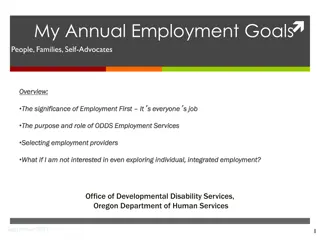
Employment and Labor Force in the Economy of Ghana
The economy of Ghana relies on a strong labor force, with individuals over 16 years old either working for pay or seeking employment. The labor force participation rate is crucial for economic growth, as a larger labor force boosts the capacity to produce goods and services. Being employed means engaging in productive activities resulting in reasonable remuneration. Full employment, where individuals are willing and able to work under prevailing conditions, is essential for a stable economy.
Download Presentation

Please find below an Image/Link to download the presentation.
The content on the website is provided AS IS for your information and personal use only. It may not be sold, licensed, or shared on other websites without obtaining consent from the author. If you encounter any issues during the download, it is possible that the publisher has removed the file from their server.
You are allowed to download the files provided on this website for personal or commercial use, subject to the condition that they are used lawfully. All files are the property of their respective owners.
The content on the website is provided AS IS for your information and personal use only. It may not be sold, licensed, or shared on other websites without obtaining consent from the author.
E N D
Presentation Transcript
ECONOMY OF GHANA EMPLOYMENT
Introduction LABOUR FORCE The labour force consists of all persons over the age of 16 who are either working for pay or actively seeking paid employment. People who are not employed and not actively seeking employment are not counted as part of the labor force. This category consists of discouraged workers and students. The labour-force participation rate is the percentage of the working- age population working or seeking employment.
Labour force (cont.) Labour Force Participation Rate: This is the proportion of the labour force to the entire population. LFPR = Labour force Population X 100 Larger labour force increases the capacity of the economy to produce goods and services.
Labour force (cont.) In order for the economy to be producing at it s full capacity, the labor force must be fully employed. If the labor force participation rate is declining, it is an indication that the number of people working and/or actively seeking employment is declining.
Employment An employed person is one who during the year is engaged in a regular work for not less than eight weeks and received either in cash or in kind directly or indirectly remuneration considered reasonable in relation to requirements for basic sustenance. Workshop on Harmonisation of Labour Market Concepts in Ghana (1996) How the GLSS 6 defines employed: Either the person was actually engaged in any work (as defined above) during the reference week, or he/she had an attachment to a job or business but for some reasons did not work during the reference week.
Employment Contd A Productive activity; One that results in output for which there is effective demand/ market One that results in positive net return to the individual, having adjusted for costs involved. Work refers to any economic activity performed by the respondent that contributes to economic production of goods and services. The work activities included in the survey are in line with the current International Labour Organization (ILO) standards.
Employment Contd Full Employment; Persons willing and able to work under the prevailing wage and working conditions are employed Natural Rate of Unemployment Unemployment level is low/ acceptable.
Table 5.5: Type of work engaged in by the currently employed population aged Urban Rural Ghana 15 years and older by locality and sex Type of work Male 47.5 Female 19.1 All 32.5 Male 12.9 Female 4.5 All 8.6 Male 29.5 Female 11.7 All 20.2 Wage employment Self-employed with employees Non-agricultural Agricultural Self-employed without employees Non-agricultural Agricultural Contributing family worker Non-agricultural Agricultural Domestic employee Apprentice Casual worker Other All 7.5 1.9 7.3 1.3 7.4 1.6 1.8 2.7 1.5 1.1 1.7 1.9 4.5 2.3 4.4 1.2 4.4 1.7 15.8 10.8 44.5 8.3 30.9 9.5 7.2 48.7 18.2 30.1 12.8 39.2 11.3 30.5 31.2 19.3 21.6 24.7 3.2 6.1 0.4 3.1 3.4 0.3 100.0 6.0 7.9 0.3 1.4 4.0 0.1 100.0 4.6 7.1 0.4 2.2 3.7 0.2 100.0 1.4 21.5 0.1 2.5 1.2 0.0 100.0 3.1 38.5 0.2 1.1 1.7 0.1 100.0 2.3 30.2 0.1 1.8 1.5 0.0 100.0 2.2 14.1 0.3 2.8 2.3 0.1 100.0 4.5 23.4 0.2 1.3 2.8 0.1 100.0 3.4 18.9 0.2 2.0 2.6 0.1 100.0
Table 5.8: Currently employed population 15 years and older by industry group, locality and sex Industry group Urban Female 14.2 0.3 12.6 0.1 0.3 0.2 43.1 0.5 9.6 0.3 1.0 0.0 1.2 0.9 0.8 4.6 1.8 0.1 7.1 1.1 100.0 Rural Female 67.9 0.8 8.1 0.0 0.1 0.2 13.3 0.0 3.8 0.0 0.1 0.0 0.3 0.2 0.0 1.2 0.5 0.0 2.4 1.1 100.0 Ghana Female 41.4 0.6 10.3 0.0 0.2 0.2 28.0 0.3 6.7 0.2 0.5 0.0 0.7 0.5 0.4 2.9 1.1 0.1 4.8 1.1 100.0 Male 19.7 2.5 11.2 0.6 0.5 10.0 17.2 12.3 1.4 1.2 1.7 0.2 2.4 2.6 2.0 6.4 1.5 1.4 4.6 0.6 100.0 All 16.8 1.4 11.9 0.3 0.4 4.8 30.9 6.1 5.7 0.7 1.4 0.1 1.8 1.7 1.4 5.5 1.7 0.7 5.9 0.9 100.0 Male 74.5 3.0 4.5 0.1 0.1 3.6 4.0 3.5 0.4 0.1 0.2 0.0 0.2 0.5 0.3 2.6 0.4 0.3 1.1 0.7 100.0 All 71.1 1.9 6.4 0.0 0.1 1.8 8.8 1.7 2.1 0.0 0.1 0.0 0.3 0.3 0.2 1.9 0.4 0.2 1.8 0.9 100.0 Male 48.2 2.8 7.7 0.3 0.3 6.7 10.3 7.7 0.9 0.6 0.9 0.1 1.3 1.5 1.2 4.4 0.9 0.8 2.8 0.6 100.0 All 44.7 1.6 9.1 0.2 0.2 3.3 19.5 3.8 3.9 0.4 0.7 0.1 1.0 1.0 0.8 3.6 1.0 0.4 3.8 0.9 100.0 Agriculture, forestry and fishing Mining and quarrying Manufacturing Electricity, gas, stream and air conditioning supply Water supply, sewerage, waste management Construction Wholesale and retail trade Transportation and storage Accommodation and food service activities Information and communication Financial and insurance activities Real estate activities Professional, scientific and technical activities Administrative and support service activities Public administration and defence Education Human health and social work activities Arts, entertainment and recreation Other service activities Activities of households as employers Total
Forms Of Employment Informal sector employment; Small scale businesses in urban economy not subjected to formal contracts or official rules and regulations such as pension, profit taxes or collective bargaining. Contracts are largely informal Tend to absorb urban workers unable to secure formal employment labour sponge Includes mechanical workshops, whole sale trade, transportation, petty trading. Labour turnover is high and incomes are relatively low.
Forms of Employment Underemployment; A measure of the extent of under-utilization of labour rather than non-utilization/ unemployment. Unemployed urban workers will tend to accept any job offered them given that they cannot remain unemployed forever. Especially In rural economy, people tend to be employed, but under-utilized. Self employed folks cannot be described as seeking work When a person works fewer hours than desired, we refer to it as visible underemployment.
Forms of Employment Based on the ILOs classification, a visibly underemployed is one; Working less than the normal duration of work determined for that activity Doing so involuntarily Seeking or being available for more work Underemployment can also be the result of higher aspiration or need, as one can earn well above the minimum wage and still consider oneself underemployed.
Unemployment Unemployment is the inability of labor-force participants to find jobs. According to the ILO, unemployment occurs when people who are available for work are without work jobs and have actively looked for work within the past four weeks. Thus the inability of willing workers to find gainful employment. According the GLSS 6 report- a person is considered as unemployed if he/she was not engaged in any work (as defined above), had no attachment to a job or business and was potentially available for jobs. As the labour force grows, making sure that all participants are fully employed becomes a critical issue.
Unemployment Contd The unemployment rate is the proportion of the labor force that is unemployed. To calculate the rate, you need to know the number of people unemployed and the number of people in the labor force. Unemployment Rate = Unemployed X 100 Labour force Based on the ILO definition, The Ghana statistical service an overall unemployment rate to be 5.8 percent in 2006 for those 15 years or older.
Type of Unemployment Structural unemployment; following advances in technology including automation of production systems, improvements in productivity and development of input substitutes, the skills of the employed are rendered obsolete. Frictional unemployment; arises following time spent in job search. Usually short term and will always be present in an economy even if economy is functioning perfectly. One reason for this has to do with lack of information on labour market. Typical situation of graduates. Cyclical Unemployment (Keynesian unemployment); Deficiencies and inefficiencies in aggregate demand during certain periods in the business cycle. Coincides with under- utilised/ unused industrial capacity or capital goods. Seasonal Unemployment; similar to cyclical unemployment, it associated with a shortfall in demand in a particular season, sector or industry rather than economy as a whole and usually short term. Modifications to jobs or structure of a sector or industry can help absorb labour and mitigate the incidence of the problem year round.
Cost of Unemployment Social and economic; Individual financial cost - Lost income Indirect Private Cost; Missed work experience Pensions and retirement benefits Indirect public financial cost Social support instead of investment Non-financial cost psychological effects and social repercussions Loss of aggregate output to nation GDPgap = Potential GDP Actual GDP
Unemployment Trends in Ghana Unemployment rates (%) in Ghana Ghana Statiscal Service. Year 1984 1991/92 1998/99 2000 2005/06 2012/2013 Male 3.2 3.7 7.5 10.1 4.6 4.8 Female 2.5 5.4 8.7 10.7 4.8 5.5 All 2.8 4.7 8.2 10.4 4.7 5.2
Table 5.15: Unemployed rates by sex, age and locality Sex/Age group Urban Rural Rural Savannah Accra (GAMA) Other Urban All Urban Rural Coastal Rural Forest All Rural Ghana Sex/Age Male 15 - 25 25 - 44 45 - 64 65+ All Female 15 - 25 25 - 44 45 - 64 65+ All Both sexes 15 - 25 25 - 44 45 - 64 65+ All 10.2 3.3 2.8 2.6 4.8 18.8 5.1 5.2 0.0 6.8 15.2 3.7 2.6 2.3 5.8 15.8 4.1 3.2 1.9 6.1 6.1 1.0 0.5 0.0 2.1 5.7 3.7 6.0 6.1 5.0 6.6 2.3 2.3 2.9 3.6 6.6 2.3 2.3 2.9 3.6 11.7 4.1 3.2 2.5 5.5 25.6 4.5 5.8 2.9 8.1 14.8 5.2 16.1 0.1 6.6 16.7 5.0 21.2 0.1 6.9 7.8 2.3 0.9 0.0 3.1 6.8 3.8 5.7 6.6 5.2 7.7 3.1 2.6 2.5 4.1 7.7 3.1 2.6 2.5 4.1 10.9 3.8 3.0 2.5 5.2 22.4 4.8 5.5 1.2 7.4 15.0 4.5 3.0 2.4 6.2 16.3 4.6 3.5 2.3 6.5 6.9 1.7 0.7 0.0 2.6 6.2 3.8 5.8 6.3 5.1 7.1 2.8 2.5 2.7 3.9 7.1 2.8 2.5 2.7 3.9
Unemployment Trends in Ghana Unemployment Trends in Ghana (GLSS 6, 2012/2013) (GLSS 6, 2012/2013) Economically active population Same proportions of economically active population (15 years and older) during the three cycle durations (75.7%) Unemployment The unemployment rate was higher during the first three cycles (2.5%) than during the 4th to 6th cycle (1.9%)
Unemployment Trends in Ghana (GLSS 6, 2012/2013 Unemployment Trends in Ghana (GLSS 6, 2012/2013) ) Cont d Cont d Time spent on activities The average time spent on activities during the first three cycles (50.7 hours) of data collection is higher than during the 4th to 6th cycles (37.3 hours)
Employment performance in Ghana (Post ERP/SAP) Despite the growth of the economy following ERP/ SAP (avg. 4.8% between 1984/2000), employment rate has lagged, growing at 3.1%. Investment has also been low, while the labour has continued to grow. Contraction of formal sector employment following public sector retrenchment exercises, privatisation, removal of subsidies and tariffs aimed at protecting inefficient SOEs, has shifted labour to the informal sector especially since job requirements are low and little capital is required to setup, although job security is unavailable. It is also the case that some have found their way back to the formal sector employed in other regions/ ministries/ sectors. The presence of over 230,000 new job seekers annually with the formal sector having an absorptive capacity of 2%, thus creating excess labour. Globalisation and unfair trade practices, along with the depreciation of the cedi and high domestic lending rates has led to downsizing or collapse of many private sector firms/industries.
Employment performance in Ghana (Post ERP/SAP) According to the Ministry of Manpower, Youth and Employment the causes of youth unemployment in Ghana include the following the introduction of the Junior Secondary School and Senior Secondary School system without adequate planning for integration into the trades/vocations and job placement; education and training have no link to the needs of the important sectors of the economy; the near collapse of Ghana s industrial base due to ineffective management of the divestiture process which resulted in the closure of many factories without a structural transformation of the economy to generate alternative jobs for people; the shrinking of public sector employment opportunities coupled with a relatively slow growth of the private sector; and the lack of a coherent national employment policy and comprehensive strategy to deal with the employment problem
Strategies Strategies for Improving Unemployment Situation in Ghana for Improving Unemployment Situation in Ghana Some initiatives have been undertaken to improve the situation of Youth employment in Ghana; the National Youth Volunteer Programme by the Ghana National Service Scheme; the establishment of the Youth Venture Capital Fund; the enactment of a new Labour Law (Act 561) to ensure a more flexible labour market environment; the enactment of the Disability Bill to address the employment needs of young persons with disability and the enactment of a demand-driven law for technical and vocational education
Strategies for Improving Unemployment Situation in Ghana Growth and Poverty Reduction Strategy Programmes (GPRSP I & II) which provide a blue-print for the nations development agenda, including interventions such as the pro-poor decentralization and good governance reforms, the Rural Enterprise Project, Alternative Livelihood Programme, the Village Infrastructure Project (VIP) and projects implemented by the Social Investment Fund (SIF) would help support the process. Some proposals for dealing with the challenge; Output growth for more employment opportunities Measures to enhance labour productivity and absorption Promote self employment and informal sector employment Special programs for vulnerable groups such as youth, women, rural population
Strategies for Improving Unemployment Situation in Ghana On labour supply; Population control Human resource training to deal with the structural causes. Q: What other strategies do you propose?






















